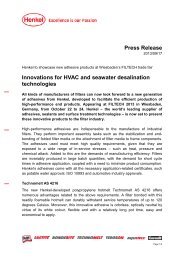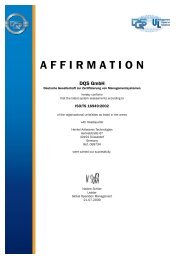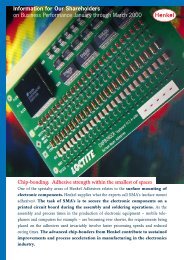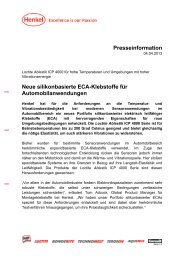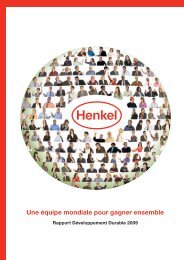Henkel Annual Report 2011 - Henkel AG & Co. KGaA Annual Report ...
Henkel Annual Report 2011 - Henkel AG & Co. KGaA Annual Report ...
Henkel Annual Report 2011 - Henkel AG & Co. KGaA Annual Report ...
You also want an ePaper? Increase the reach of your titles
YUMPU automatically turns print PDFs into web optimized ePapers that Google loves.
<strong>Henkel</strong> <strong>Annual</strong> <strong>Report</strong> <strong>2011</strong><br />
previous year, as the expected return from reimbursement<br />
rights corresponded to the actual return generated.<br />
The reclassifications had the following effects on the relevant<br />
items of the consolidated statement of financial position<br />
dated December 31, 2010:<br />
Reclassifications<br />
in million euros<br />
Dec. 31,<br />
2010<br />
Non-current assets 15<br />
Other financial assets – 90<br />
Other assets 105<br />
Current assets – 15<br />
Other financial assets – 24<br />
Other assets 9<br />
Non-current liabilities 3<br />
Pension obligations 50<br />
Other financial liabilities – 55<br />
Other liabilities 8<br />
Current liabilities –3<br />
Other financial liabilities – 28<br />
Other liabilities 25<br />
Accounting estimates, assumptions and discretionary<br />
judgments<br />
Preparation of the consolidated financial statements is based<br />
on a number of accounting estimates and assumptions. These<br />
have an impact on the reported amounts of assets, liabilities<br />
and contingent liabilities at the reporting date and the disclosure<br />
of income and expenses for the reporting period. The<br />
actual amounts may differ from these estimates.<br />
The accounting estimates and their underlying assumptions<br />
are continually reviewed. Changes in accounting estimates<br />
are recognized in the period in which the change takes place<br />
where such change exclusively affects that period. A change<br />
is recognized in the period in which it occurs and in later<br />
periods where such change affects both the reporting period<br />
and subsequent periods. The judgments of the Management<br />
Board regarding the application of those IFRSs which have a<br />
significant impact on the consolidated financial statements<br />
are presented in the explanatory notes on taxes on income<br />
(Note 30 on pages 140 to 142), intangible assets (Note 1 on<br />
pages 111 to 114), pension obligations (Note 15 on pages<br />
120 to 124), financial instruments (Note 21 on pages 128 to<br />
138) and share-based payment plans (Note 32 on pages 143<br />
to 145).<br />
<strong>Co</strong>nsolidated financial statements<br />
Accounting principles and methods applied in preparation<br />
of the consolidated financial statements<br />
Essentially, discretionary judgments are made in respect of<br />
the following two areas:<br />
∙ The US dollar liabilities of <strong>Henkel</strong> of America, Inc. are set<br />
off against sureties of <strong>Henkel</strong> <strong>AG</strong> & <strong>Co</strong>. <strong>KGaA</strong>, as the deposit<br />
and the loan are with the same lender and of the same<br />
maturity, there is a legal right to set off these sums and the<br />
Group intends to settle net.<br />
∙ The demarcation of the cash-generating units is also a<br />
discretionary judgment of the Group management and<br />
is explained under Note 1 on pages 111 to 114.<br />
New international accounting regulations according to<br />
International Financial <strong>Report</strong>ing Standards (IFRS)<br />
Accounting regulations applied for the first time in the year<br />
under review<br />
Application of the following standards, amendments and<br />
interpretations has been mandatory since January 1, <strong>2011</strong>:<br />
Accounting regulations applied for the first time in the year<br />
under review<br />
<strong>Co</strong>llective standard: “Improvements to IFRS 2010”<br />
Significance<br />
Minor<br />
IAS 24 (Rev. 2009) “Related Party Disclosures” Irrelevant<br />
IAS 32 “Classification of Rights Issues” (Amendment)<br />
IFRIC 14 “Prepayments of a Minimum Funding Require-<br />
Irrelevant<br />
ment” (Amendment)<br />
IFRIC 19 “Extinguishing Financial Liabilities with Equity<br />
Irrelevant<br />
Instruments” Irrelevant<br />
• In May 2010, the International Accounting Standards Board<br />
(IASB) issued amendments of existing standards and interpretations<br />
as part of its annual improvement project. In<br />
addition to editorial revisions introduced to clarify existing<br />
regulations, amendments also relate to changes of individual<br />
standards affecting recognition, measurement or disclosure.<br />
• In November 2009, the IASB published a revision of IAS 24<br />
“Related Party Disclosures.” The revised standard clarifies<br />
the definition of a related party and simplifies the disclosure<br />
requirement for government-related entities.<br />
• In October 2009, the IASB published amendments to<br />
International Accounting Standard (IAS) 32 “Financial<br />
Instruments: Presentation.” The amendments stipulate the<br />
accounting at the issuer of pre-emptive rights, options and<br />
warrants issued to acquire a fixed number of equity instruments<br />
that are denominated in a currency other than that<br />
of the issuer. Such cases were hitherto reported as derivative<br />
liabilities. Pre-emptive rights that are issued pro rata at a<br />
fixed currency amount to the existing shareholders of a<br />
company are in future to be classified as equity. The<br />
currency in which the exercise price is stated is irrelevant.<br />
109



